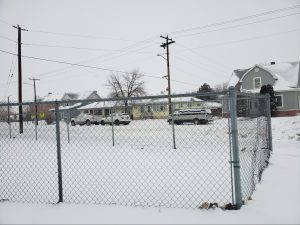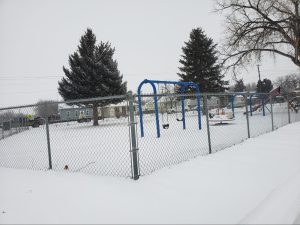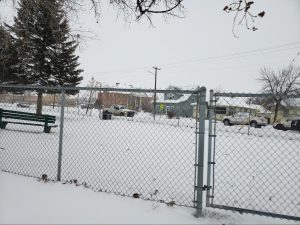
Photo of Sacred Heart Chain-Link Fence, where many kids learn to unicycle from Curt Almy.
Chain-Link Fence is a common option for residential and commercial property owners because of its affordable price and wide range of useful applications. When compared to the other fencing options, both the material and the installation of this one are the least expensive. Here are some of the most significant drawbacks of having a chain-link fence installed on your property, in our opinion, if you are considering doing so.

Photo of Triangle Park, a beloved little park located in Miles City, MT, which is surrounded by a Chain-Link fence.
The rusting of the chain-wire fence’s posts and, on occasion, the wire itself is the most common and troublesome problem associated with this type of fencing. Products of higher quality provide a more lasting material that is also better able to prevent rust from forming. To guarantee that a good coating is placed on the fencing in order to prevent rusting from occurring, it is vital to make sure to contact a qualified provider.
Rust doesn’t look nice, so as the chain link fence in your yard begins to rust, you will have two options: either clean the rust with a wire brush and then refinish the chain link with rust-resistant paint, which will take time and money; or, you can replace the broken parts of the fence altogether. It is important to keep in mind that in order to keep your chain-link fence in good condition, you will need to apply a rust-resistant coating once a year. And naturally, doing that year after year can eat up a considerable amount of time.

Photo of Triangle Park, a beloved little park located in Miles City, MT, which is surrounded by a Chain-Link fence.
To a certain extent, a chain-link fence can be an acceptable means of securing your backyard from intruders like pets and children. However, it won’t prevent your dog from jumping over the fence or your nosy neighbors from peering in. The sharp edges of a chain-link fence can cause scratches, cuts, and even diseases like tetanus as the fence rusts over time, and yet kids and big dogs are drawn to it. Chain-link fences are not designed to provide privacy or security. If privacy is your main concern, then your best bet for that is a solid privacy fence.

Photo of Sacred Heart Chain-Link Fence, where many kids learn to unicycle from Curt Almy.
A chain-link fence, while functional, can actually decrease the value of your home. Potential buyers won’t be interested in purchasing your home if it has a fence that needs constant upkeep. Many homebuyers will see a chain-link fence as more of a detriment than an advantage. The chain-link fence’s visual appeal is another consideration. When other houses in your neighborhood have sleek vinyl or aluminum fencing, your choice of chain link may seem dated and unattractive. Some homeowners’ associations are revising their policies to ban the use of chain links entirely, requiring homeowners to find and pay for alternatives. Therefore, a chain-link fence is often an expensive upgrade in waiting. However, a fence that doesn’t require constant upkeep can increase the value of your home significantly. A savvy buyer will prioritize options like these because of their lower cost of ownership over time, higher aesthetic value, and increased durability.

Photo of Curt Almy teaching Smokey The Bear how to ride a unicycle inside the Miles Community College gym.
The life expectancy of your chain-link fence is around 15 years. In contrast, the lifespan of wood is approximately 15–20 years, the lifespan of vinyl is approximately 20–30 years, the lifespan of aluminum is over 50 years, and the lifespan of wrought iron is centuries. On the other hand, how often you take care of your fence will either greatly increase or decrease the amount of time you can expect it to serve its purpose. While chain-link fences are designed to last significantly longer than their wooden equivalents, it is still possible for them to sag if the tension wires or posts are not maintained properly. Not only is it an annoyance when the hinges on your gate corrode or become worn out from regular use, but it also poses a threat to your safety. You should set aside some money for the fence’s upkeep so that it stays in good shape over the next few years.

Photo of Triangle Park, a beloved little park located in Miles City, MT, which is surrounded by a Chain-Link fence.
How much would it cost to put up a cheap fence?
When it comes to fence materials, chain link is by far the most affordable option.
In the United States, the cost of putting up a fence, including labor, materials, and professional installation, is roughly $3,000. Still, the type of material you choose will be one of the main things that affects how much you spend overall.
Chain Link: $15–$30
Wood: $17-45
Vinyl: $10-$40
Aluminum/Steel: $17-$90
Composite: $11-$45
Composite: $11-$45
Should you find yourself with more questions, we at Cat’s Claw Fasteners are here to assist! Please forward your queries to our Head Cat Collector, Ralph, at ra***@***************rs.com. Be sure to explore our other blog posts and stay connected with us on Facebook, Instagram, Pinterest, and Youtube!
Read Next: What Are the Pros and Cons of a DIY Fence?

© 2024 Cat's Claw Fasteners, LLC | All Rights Reserved - Built by Redemptive Software